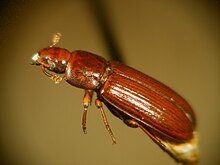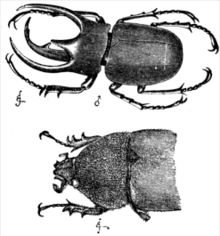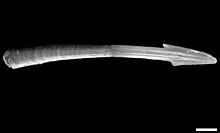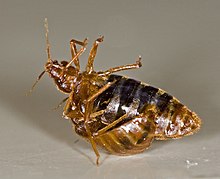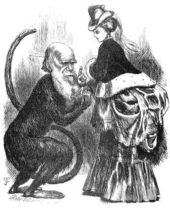Sexual selection creates colourful differences between sexes (sexual dimorphism) in Goldie's bird-of-paradise. Male above; female below. Painting by John Gerrard Keulemans (d.1912)
Sexual
selection is a form of natural selection where one sex prefers a
specific characteristic in an individual of the other sex. Peafowls
exhibit sexual selection, in that, peahens look for peacocks with more
"eyes" on their tail feathers. This results in the peacocks with more
eyes reproducing more, leading to peacocks with more eyes becoming more
common in subsequent generations.
Sexual selection is a mode of natural selection where members of one biological sex choose mates of the other sex to mate
with (intersexual selection), and compete with members of the same sex
for access to members of the opposite sex (intrasexual selection). These
two forms of selection mean that some individuals have better reproductive success than others within a population, either from being more attractive or preferring more attractive partners to produce offspring. For instance, in the breeding season, sexual selection in frogs occurs with the males first gathering at the water's edge and making their mating calls:
croaking. The females then arrive and choose the males with the deepest
croaks and best territories. In general, males benefit from frequent
mating and monopolizing access to a group of fertile females. Females
can have a limited number of offspring and maximize the return on the
energy they invest in reproduction.
The concept was first articulated by Charles Darwin and Alfred Russel Wallace
who described it as driving species adaptations and that many organisms
had evolved features whose function was deleterious to their individual
survival, and then developed by Ronald Fisher in the early 20th century. Sexual selection can, typically, lead males to extreme efforts to demonstrate their fitness to be chosen by females, producing sexual dimorphism in secondary sexual characteristics, such as the ornate plumage of birds such as birds of paradise and peafowl, or the antlers of deer, or the manes of lions, caused by a positive feedback mechanism known as a Fisherian runaway,
where the passing-on of the desire for a trait in one sex is as
important as having the trait in the other sex in producing the runaway
effect. Although the sexy son hypothesis indicates that females would prefer male offspring, Fisher's principle explains why the sex ratio is 1:1 almost without exception. Sexual selection is also found in plants and fungi.
The maintenance of sexual reproduction in a highly competitive world is one of the major puzzles in biology given that asexual reproduction
can reproduce much more quickly as 50% of offspring are not males,
unable to produce offspring themselves. Many non-exclusive hypotheses
have been proposed,
including the positive impact of an additional form of selection,
sexual selection, on the probability of persistence of a species.
History
Darwin
Sexual selection was first proposed by Charles Darwin in The Origin of Species (1859) and developed in The Descent of Man and Selection in Relation to Sex
(1871), as he felt that natural selection alone was unable to account
for certain types of non-survival adaptations. He once wrote to a
colleague that "The sight of a feather in a peacock's tail, whenever I gaze at it, makes me sick!" His work divided sexual selection into male-male competition and female choice.
... depends, not on a struggle for existence, but on a struggle between the males for possession of the females; the result is not death to the unsuccessful competitor, but few or no offspring.
... when the males and females of any animal have the same general habits ... but differ in structure, colour, or ornament, such differences have been mainly caused by sexual selection.
These views were to some extent opposed by Alfred Russel Wallace,
mostly after Darwin's death. He accepted that sexual selection could
occur, but argued that it was a relatively weak form of selection. He
argued that male-male competitions were forms of natural selection, but
that the "drab" peahen's coloration is itself adaptive as camouflage. In his opinion, ascribing mate choice to females was attributing the ability to judge standards of beauty to animals (such as beetles) far too cognitively undeveloped to be capable of aesthetic feeling.
Ronald Fisher
Ronald Fisher, the English statistician and evolutionary biologist developed a number of ideas about sexual selection in his 1930 book The Genetical Theory of Natural Selection including the sexy son hypothesis and Fisher's principle. The Fisherian runaway
describes how sexual selection accelerates the preference for a
specific ornament, causing the preferred trait and female preference for
it to increase together in a positive feedback runaway cycle. In a remark that was not widely understood for another 50 years he said:
... plumage development in the male, and sexual preference for such developments in the female, must thus advance together, and so long as the process is unchecked by severe counterselection, will advance with ever-increasing speed. In the total absence of such checks, it is easy to see that the speed of development will be proportional to the development already attained, which will therefore increase with time exponentially, or in geometric progression. —Ronald Fisher, 1930
This causes a dramatic increase in both the male's conspicuous feature and in female preference for it, resulting in marked sexual dimorphism, until practical physical constraints halt further exaggeration. A positive feedback
loop is created, producing extravagant physical structures in the
non-limiting sex. A classic example of female choice and potential
runaway selection is the long-tailed widowbird.
While males have long tails that are selected for by female choice,
female tastes in tail length are still more extreme with females being
attracted to tails longer than those that naturally occur.
Fisher understood that female preference for long tails may be passed
on genetically, in conjunction with genes for the long tail itself.
Long-tailed widowbird offspring of both sexes inherit both sets of
genes, with females expressing their genetic preference for long tails, and males showing off the coveted long tail itself.
Richard Dawkins presents a non-mathematical explanation of the runaway sexual selection process in his book The Blind Watchmaker.
Females that prefer long tailed males tend to have mothers that chose
long-tailed fathers. As a result, they carry both sets of genes in their
bodies. That is, genes for long tails and for preferring long tails
become linked.
The taste for long tails and tail length itself may therefore become
correlated, tending to increase together. The more tails lengthen, the
more long tails are desired. Any slight initial imbalance between taste
and tails may set off an explosion in tail lengths. Fisher wrote that:
The exponential element, which is the kernel of the thing, arises from the rate of change in hen taste being proportional to the absolute average degree of taste. —Ronald Fisher, 1932
The peacock tail in flight, the classic example of a Fisherian runaway
The female widow bird chooses to mate with the most attractive
long-tailed male so that her progeny, if male, will themselves be
attractive to females of the next generation - thereby fathering many
offspring that carry the female's genes. Since the rate of change in
preference is proportional to the average taste amongst females, and as
females desire to secure the services of the most sexually attractive
males, an additive effect is created that, if unchecked, can yield
exponential increases in a given taste and in the corresponding desired
sexual attribute.
It is important to notice that the conditions of relative stability brought about by these or other means, will be far longer duration than the process in which the ornaments are evolved. In most existing species the runaway process must have been already checked, and we should expect that the more extraordinary developments of sexual plumage are not due like most characters to a long and even course of evolutionary progress, but to sudden spurts of change. —Ronald Fisher, 1930
Since Fisher's initial conceptual model of the 'runaway' process, Russell Lande and Peter O'Donald have provided detailed mathematical proofs that define the circumstances under which runaway sexual selection can take place.
Theory
Reproductive success
Extinct Irish elk (Megaloceros giganteus). These antlers span 2.7 metres (8.9 ft) and have a mass of 40 kg (88 lb).
The reproductive success of an organism is measured by the number of offspring left behind, and their quality or probable fitness.
Sexual preference creates a tendency towards assortative mating or homogamy.
The general conditions of sexual discrimination appear to be (1) the
acceptance of one mate precludes the effective acceptance of alternative
mates, and (2) the rejection of an offer is followed by other offers,
either certainly or at such high chance that the risk of non-occurrence
is smaller than the chance advantage to be gained by selecting a mate.
The conditions determining which sex becomes the more limited resource in intersexual selection have been hypothesized with Bateman's principle,
which states that the sex which invests the most in producing offspring
becomes a limiting resource for which the other sex competes,
illustrated by the greater nutritional investment of an egg in a zygote,
and the limited capacity of females to reproduce; for example, in
humans, a woman can only give birth every ten months, whereas a male can
become a father numerous times in the same period.
Modern interpretation
Male mountain gorilla, a tournament species
The sciences of evolutionary psychology, human behavioural ecology, and sociobiology study the influence of sexual selection in humans.
Darwin's ideas on sexual selection were met with scepticism by
his contemporaries and not considered of great importance in the early
20th century, until in the 1930s biologists decided to include sexual
selection as a mode of natural selection. Only in the 21st century have they become more important in biology. The theory however is generally applicable and analogous to natural selection.
Flour beetle
Tungara frog
Research in 2015 indicates that sexual selection, including mate choice,
"improves population health and protects against extinction, even in
the face of genetic stress from high levels of inbreeding" and
"ultimately dictates who gets to reproduce their genes into the next
generation - so it's a widespread and very powerful evolutionary force."
The study involved the flour beetle over a ten-year period where the only changes were in the intensity of sexual selection.
Another theory, the handicap principle of Amotz Zahavi, Russell Lande and W. D. Hamilton,
holds that the fact that the male is able to survive until and through
the age of reproduction with such a seemingly maladaptive trait is taken
by the female to be a testament to his overall fitness. Such handicaps
might prove he is either free of or resistant to disease,
or that he possesses more speed or a greater physical strength that is
used to combat the troubles brought on by the exaggerated trait.
Zahavi's work spurred a re-examination of the field, which has produced
an ever-accelerating number of theories. In 1984, Hamilton and Marlene Zuk
introduced the "Bright Male" hypothesis, suggesting that male
elaborations might serve as a marker of health, by exaggerating the
effects of disease and deficiency. In 1990, Michael Ryan and A.S. Rand,
working with the tungara frog,
proposed the hypothesis of "Sensory Exploitation", where exaggerated
male traits may provide a sensory stimulation that females find hard to
resist. Subsequently, the theories of the "Gravity Hypothesis" by Jordi
Moya-Larano et al. (2002), invoking a simple biomechanical model to
account for the adaptive value for smaller male spiders of speed in
clmbing vertical surfaces,
and "Chase Away" by Brett Holland and William R. Rice have been added.
In the late 1970s, Janzen and Mary Willson, noting that male flowers are
often larger than female flowers, expanded the field of sexual
selection into plants.
In the past few years, the field has exploded to include other
areas of study, not all of which fit Darwin's definition of sexual
selection. These include cuckoldry, nuptial gifts, sperm competition, infanticide (especially in primates), physical beauty,
mating by subterfuge, species isolation mechanisms, male parental care,
ambiparental care, mate location, polygamy, and homosexual rape in
certain male animals.
Focusing on the effect of sexual conflict, as hypothesized by William Rice, Locke Rowe et Göran Arnvist, Thierry Lodé argues that divergence of interest constitutes a key for evolutionary process. Sexual conflict leads to an antagonistic co-evolution in which one sex tends to control the other, resulting in a tug of war. Besides, the sexual propaganda theory
only argued that mates were opportunistically led, on the basis of
various factors determining the choice such as phenotypic
characteristics, apparent vigour of individuals, strength of mate
signals, trophic resources, territoriality, etc., but and could explain
the maintenance of genetic diversity within populations.
Several workers have brought attention to the fact that
elaborated characters that ought to be costly in one way or another for
their bearers (e.g., the tails of some species of Xiphophorus
fish) do not always appear to have a cost in terms of energetics,
performance or even survival. One possible explanation for the apparent
lack of costs is that "compensatory traits" have evolved in concert with
the sexually selected traits.
Toolkit of natural selection
Protarchaeopteryx - skull based on Incisivosaurus and wings on Caudipteryx
Sexual selection may explain how certain characteristics (such as
feathers) had distinct survival value at an early stage in their
evolution. Geoffrey Miller proposes that sexual selection might have contributed by creating evolutionary modules such as Archaeopteryx feathers as sexual ornaments, at first. The earliest proto-birds such as China's Protarchaeopteryx,
discovered in the early 1990s, had well-developed feathers but no sign
of the top/bottom asymmetry that gives wings lift. Some have suggested
that the feathers served as insulation, helping females incubate their
eggs. But perhaps the feathers served as the kinds of sexual ornaments
still common in most bird species, and especially in birds such as
peacocks and birds-of-paradise
today. If proto-bird courtship displays combined displays of forelimb
feathers with energetic jumps, then the transition from display to
aerodynamic functions could have been relatively smooth.
Sexual selection sometimes generates features that may help cause a species' extinction, as has been suggested for the giant antlers of the Irish elk (Megaloceros giganteus) that became extinct in Pleistocene Europe. However, sexual selection can also do the opposite, driving species divergence - sometimes through elaborate changes in genitalia - such that new species emerge.
Sexual dimorphism
Sex differences directly related to reproduction and serving no direct purpose in courtship are called primary sexual characteristics.
Traits amenable to sexual selection, which give an organism an
advantage over its rivals (such as in courtship) without being directly
involved in reproduction, are called secondary sex characteristics.
The rhinoceros beetle is a classic case of sexual dimorphism. Plate from Darwin's Descent of Man, male at top, female at bottom
In most sexual species the males and females have different equilibrium
strategies, due to a difference in relative investment in producing
offspring. As formulated in Bateman's principle, females have a greater
initial investment in producing offspring (pregnancy in mammals or the production of the egg in birds and reptiles),
and this difference in initial investment creates differences in
variance in expected reproductive success and bootstraps the sexual
selection processes. Classic examples of reversed sex-role species
include the pipefish, and Wilson's phalarope. Also, unlike a female, a male (except in monogamous
species) has some uncertainty about whether or not he is the true
parent of a child, and so is less interested in spending his energy
helping to raise offspring that may or may not be related to him. As a
result of these factors, males are typically more willing to mate than
females, and so females are typically the ones doing the choosing
(except in cases of forced copulations, which can occur in certain species of primates, ducks, and others). The effects of sexual selection are thus held to typically be more pronounced in males than in females.
Differences in secondary sexual characteristics between males and females of a species are referred to as sexual dimorphisms.
These can be as subtle as a size difference (sexual size dimorphism,
often abbreviated as SSD) or as extreme as horns and colour patterns.
Sexual dimorphisms abound in nature. Examples include the possession of
antlers by only male deer,
the brighter coloration of many male birds in comparison with females
of the same species, or even more distinct differences in basic
morphology, such as the drastically increased eye-span of the male stalk-eyed fly. The peacock, with its elaborate and colourful tail feathers, which the peahen lacks, is often referred to as perhaps the most extraordinary example of a dimorphism. Male and female black-throated blue warblers and Guianan cock-of-the-rocks
also differ radically in their plumage. Early naturalists even believed
the females to be a separate species. The largest sexual size
dimorphism in vertebrates is the shell dwelling cichlid fish Neolamprologus callipterus in which males are up to 30 times the size of females. Many other fish such as guppies also exhibit sexual dimorphism. Extreme sexual size dimorphism, with females larger than males, is quite common in spiders and birds of prey.
The Role of Male-Male Competition in Sexual Selection
Male-male competition occurs when two males of the same species compete for the opportunity to mate with a female. Sexually dimorphic traits, size, sex ratio and the social situation
may all play a role in the effects male-male competition has on the
reproductive success of a male and the mate choice of a female.
Conditions that Influence Competition
Sex Ratio
Japanese medaka, Orzyas latipes.
There are multiple types of male-male competition that may occur in a
population at different times depending on the conditions. Competition
variation occurs based on the frequency of various mating behaviours
present in the population. One factor that can influence the type of competition observed is the population density of males.
When there is a high density of males present in the population,
competition tends to be less aggressive and therefore sneak tactics and
disruptions techniques are more often employed. These techniques often indicate a type of competition referred to as scramble competition. In Japanese medaka, Oryzias latipes,
sneaking behaviours refer to when a male interrupts a mating pair
during copulation by grasping on to either the male or the female and
releasing their own sperm in the hopes of being the one to fertilize the
female.
Disruption is a technique which involves one male bumping the male that
is copulating with the female away just before his sperm is released
and the eggs are fertilized.
However, all techniques are not equally successful when in
competition for reproductive success. Disruption results in a shorter
copulation period and can therefore disrupt the fertilization of the
eggs by the sperm, which frequently results in lower rates of
fertilization and smaller clutch size.
Resource Value and Social Ranking
Another
factor that can influence male-male competition is the value of the
resource to competitors. Male-male competition can pose many risks to a
male's fitness, such as high energy expenditure, physical injury, lower
sperm quality and lost paternity.
The risk of competition must therefore be worth the value of the
resource. A male is more likely to engage in competition for a resource
that improves their reproductive success if the resource value is
higher. While male-male competition can occur in the presence or absence
of a female, competition occurs more frequently in the presence of a
female.
The presence of a female directly increases the resource value of a
territory or shelter and so the males are more likely to accept the risk
of competition when a female is present. The smaller males of a species are also more likely to engage in competition with larger males in the presence of a female.
Due to the higher level of risk for subordinate males, they tend to
engage in competition less frequently than larger, more dominant males
and therefore breed less frequently than dominant males. This is seen in many species, such as the Omei treefrog, Rhacophorus omeimontis, where larger males obtained more mating opportunities and successfully mated with larger mates.
Winner-Loser Effects
A third factor that can impact the success of a male in competition is winner-loser effects. Burrowing crickets, velarifictorous aspersus, compete for burrows to attract females using their large mandibles for fighting. Female burrowing crickets, are more likely to choose winner of a competition in the 2 hours after the fight.
The presence winning male suppresses mating behaviours of the losing
males because the winning male tends to produce more frequent and
enhanced mating calls in this period of time.
Effect of Male-Male Competition on Female Fitness
Male-male
competition can both positively and negatively affect female fitness.
When there is a high density of males in a population and a large number
of males attempting to mate with the female, she is more likely to
resist mating attempts, resulting in lower fertilization rates. High levels of male-male competition can also result in a reduction in female investment in mating. Many forms of competition can also cause significant distress for the female negatively impacting her ability to reproduce.
An increase in male-male competition can affect a females ability to
select the best mates, and therefore decrease the likelihood of
successful reproduction.
However, group mating in Japanese medaka
has been shown to positively affect the fitness of females due to an
increase in genetic variation, a higher likelihood of paternal care and a
higher likelihood of successful fertilization.
Examples
A leaf-footed cactus bug, Narnia femorata.
In Japanese medaka, females mate daily during mating season. Males compete for the opportunity to mate with the female by displaying themselves aggressively and chasing each other.
To obtain the selection of the females, they court the females prior to
copulation by performing a courting behaviour referred to as "quick
circles".
In leaf-footed cactus bugs, Narnia femorata, males compete for territories where females can lay their eggs. Males compete more intensely for cacti territories with fruit to attract females. In this species, the males possess sexually dimorphic traits, such as
their larger size and hind legs, which are used to gain the most
advantage over competitors when females are present, but are not used in
the absence of females.
Anuran (such as frogs) select habitats (pools) free of conspecifics in order to minimize male-male competition for both themselves and their offspring.
Displays are used in attempt to keep competitors out of their territory
and deter sneaking behaviours, while fighting is only used when
necessary due to the high costs and risks associated with fighting.
In different taxa
SEM image of lateral view of a love dart of the land snail Monachoides vicinus. The scale bar is 500 μm (0.5 mm).
- Sexual selection in birds - mammals - humans -scaled reptiles - amphibians - insects - spiders - major histocompatibility complex
Human spermatozoa can reach 250 million in a single ejaculation
Sexual selection has been observed to occur in plants, animals and fungi. In certain hermaphroditic snail and slug species of molluscs the throwing of love darts is a form of sexual selection. Certain male insects of the lepidoptera order of insects cement the vaginal pores of their females.
Today, biologists say that certain evolutionary traits can be explained by intraspecific competition - competition between members of the same species - distinguishing between competition before or after sexual intercourse.
Illustration from The Descent of Man showing the tufted coquette Lophornis ornatus: female on left, ornamented male on right
Before copulation, intrasexual selection - usually between males - may take the form of male-to-male combat. Also, intersexual selection, or mate choice, occurs when females choose between male mates.
Traits selected by male combat are called secondary sexual
characteristics (including horns, antlers, etc.), which Darwin described
as "weapons", while traits selected by mate (usually female) choice are
called "ornaments". Due to their sometimes greatly exaggerated nature,
secondary sexual characteristics can prove to be a hindrance to an
animal, thereby lowering its chances of survival. For example, the large
antlers of a moose are bulky and heavy and slow the creature's flight
from predators; they also can become entangled in low-hanging tree
branches and shrubs, and undoubtedly have led to the demise of many
individuals. Bright colourations and showy ornamenations, such as those
seen in many male birds, in addition to capturing the eyes of females,
also attract the attention of predators. Some of these traits also
represent energetically costly investments for the animals that bear
them. Because traits held to be due to sexual selection often conflict
with the survival fitness of the individual, the question then arises as
to why, in nature, in which survival of the fittest
is considered the rule of thumb, such apparent liabilities are allowed
to persist. However, one must also consider that intersexual selection
can occur with an emphasis on resources that one sex possesses rather
than morphological and physiological differences. For example, males of Euglossa imperialis,
a non-social bee species, form aggregations of territories considered
to be leks, to defend fragrant-rich primary territories. The purpose of
these aggregations is only facultative, since the more suitable
fragrant-rich sites there are, the more habitable territories there are
to inhabit, giving females of this species a large selection of males
with whom to potentially mate.
After copulation, male–male competition distinct from conventional aggression may take the form of sperm competition, as described by Parker in 1970. More recently, interest has arisen in cryptic female choice, a phenomenon of internally fertilised animals such as mammals and birds, where a female can get rid of a male's sperm without his knowledge.
Victorian
cartoonists quickly picked up on Darwin's ideas about display in sexual
selection. Here he is fascinated by the apparent steatopygia in the latest fashion.
Finally, sexual conflict is said to occur between breeding partners, sometimes leading to an evolutionary arms race between males and females. Sexual selection can also occur as a product of pheromone release, such as with the stingless bee, Trigona corvina.
Female mating preferences are widely recognized as being
responsible for the rapid and divergent evolution of male secondary
sexual traits.
Females of many animal species prefer to mate with males with external
ornaments - exaggerated features of morphology such as elaborate sex
organs. These preferences may arise when an arbitrary female preference
for some aspect of male morphology — initially, perhaps, a result of genetic drift — creates, in due course, selection for males with the appropriate ornament. One interpretation of this is known as the sexy son hypothesis. Alternatively, genes that enable males to develop impressive ornaments or fighting ability may simply show off greater disease resistance or a more efficient metabolism, features that also benefit females. This idea is known as the good genes hypothesis.
Bright colors that develop in animals during mating season
function to attract partners. It has been suggested that there is a
causal link between strength of display of ornaments involved in sexual
selection and free radical biology. To test this idea, experiments were performed on male painted dragon lizards.
Male lizards are brightly conspicuous in their breeding coloration,
but their color declines with aging. Experiments involving
administration of antioxidants to these males led to the conclusion that breeding coloration is a reflection of innate anti-oxidation capacity that protects against oxidative damage, including oxidative DNA damage. Thus color could act as a “health certificate” that allows females to visualize the underlying oxidative stress induced damage in potential mates.
Darwin conjectured that heritable traits such as beards and hairlessness in different human populations are results of sexual selection in humans. Geoffrey Miller
has hypothesized that many human behaviours not clearly tied to
survival benefits, such as humour, music, visual art, verbal creativity,
and some forms of altruism,
are courtship adaptations that have been favoured through sexual
selection. In that view, many human artefacts could be considered
subject to sexual selection as part of the extended phenotype, for instance clothing that enhances sexually selected traits. Some argue that the evolution of human intelligence is a sexually selected trait, as it would not confer enough fitness in itself relative to its high maintenance costs.






